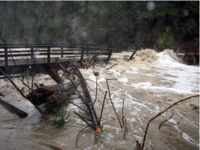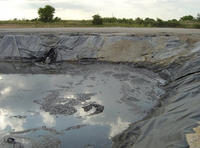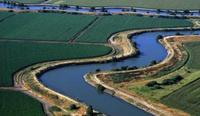-
Heavy snows divert Colorado River water shortage, for now

This winter, heavy snowfall in Utah, Colorado, and Wyoming have helped to avert a water crisis along the Colorado River; after an eleven year drought in the region, residents have begun to worry about impending water shortages; the Colorado River supplies nearly thirty million people in seven states with drinking water as well as Mexico; the heavy snows could bring only a brief moment of respite; with demand exceeding supplies and with each year bringing less water, there is potential for a future disaster; if supplies continue to decline, water deliveries will be reduced when Lake Mead’s water level drops below 1,075 feet; as of 1 February, Lake Mead’s water level was at 1,091feet
-
-
Water infrastructure budgets to see massive cuts in 2012
Next year water infrastructure projects and programs are expected to see massive budget cuts as President Obama has proposed slashing infrastructure spending at the Environmental Protection Agency (EPA) and the U.S. Army Corps of Engineers; the Drinking Water State Revolving Fund (SRF) will see nearly $400 million cuts and the Clean Water SRF will be cut nearly $600 million; according to Lisa Jackson, the EPA administrator, these cuts in SRF budgets reflect a return to a more “sustainable level”; states worry that cuts will make it difficult to fund future infrastructure upgrades; reports have shown that the United States faces a $500 billion shortfall for water infrastructure funding over the next twenty years
-
-
Lodi, CA considers privatizing $36 million water plant
The city of Lodi, California is in the midst of building a new $36 million water treatment plant, and is considering privatizing the facility; the new plant will open in 2012 and provide the city with one-third of its drinking water; Lodi is in a tight financial situation and is considering methods to reduce costs like privatizing the new treatment plant; the treatment facility is expected to cost $1.8 million to operate annually with an additional $1 million for payroll; Lodi residents have proposed that the city hire a private company to save money on payroll
-
-
Politics stalls $250 million water plant in North Vegas
A $250 million wastewater treatment plant in North Las Vegas suffered a major setback after county commissioners denied the plant’s request to use county land; the city had planned to route treated water through unincorporated county territory and pay the county $50,000 a year, but the county voted six to one against the plan; county commissioners say that the city has not been cooperative; commissioners were particularly upset about the city’s lucrative deal with Nellis Air Force Base that would take $1.25 million in revenues from the county each year; the plant has been under construction for years and needed the use of a Clark County pipeline to operate
-
-
New tool to build water infrastructure resiliency
The Environmental Protection Agency (EPA) is set to roll out its new Community-Based Water Resiliency (CBWR) Electronic Tool this spring; the tool is designed to give organizations in charge of critical water infrastructure a way to assess their community’s ability to continue delivering water in the event of service disruptions and enhance resiliency; a major natural disaster or terrorist attack could leave large portions of a state without access to drinking water for months; Matthew Everett from the EPA will be present at the upcoming Government and Security Expo to discuss the EPA’s new initiative; the conference will be held from 29 March to 31 March in Washington, D.C.
-
-
Scientists: water woes ahead

Within a generation, water demand in many countries is forecast to exceed supply by an estimated 40 percent.
In other parts of the world prone to flooding, catastrophic floods normally expected once a century could occur every twenty years instead; meanwhile, spending on technologies and services to discover, manage, filter, disinfect, and desalinate water, improve infrastructure and distribution, mitigate flood damage, and reduce water consumption by households, industry, and agriculture is expected to rise to a trillion dollars annually by 2020 -
-
Mitigation policy could halve climate-related impacts on water scarcity
Even without the effects of climate change, as much as 40 percent of the world’s population will be living under water scarce conditions by 2020; climate change is expected to influence future water scarcity through regional changes in precipitation and evaporation; most climate models suggest rainfall is likely to decrease in the subtropics and increase in mid-latitudes and some parts of the tropics; in the latter, mitigation efforts could actually reduce the amount of extra water potentially available
-
-
Radioactive waste contaminates drinking water, EPA does nothing

Recent Environmental Protection Agency (EPA) documents show that Pennsylvania’s drinking water has been contaminated with radioactive waste from natural gas drilling; energy companies have been extracting natural gas with a new drilling technique called “hydrofracking”; this process results in millions of gallons of wastewater that is contaminated with dangerous chemicals like highly corrosive salts, carcinogens, and radioactive elements; EPA documents reveal the process has been contaminating drinking water supplies across the country with radioactive waste; in Pennsylvania more than 1.3 billion gallons of radioactive wastewater was trucked to plants that could not process out the toxins before it released the water into drinking supplies
-
-
Expert urges broad reforms in managing California's water

Most threatening to California’s water situation is the vulnerability of the hub of the state’s fresh water system, the Sacramento-San Joaquin delta, which drains water from the northern Sierra mountains; over the past century, farmers have built a network of more than 1,700 kilometers of levees to protect farmland in the delta from floodwaters; those levees are weak and vulnerable to earthquakes, seasonal floods, and rising waters expected as a result of climate change; the failure of even a fraction of the levees would draw massive amounts of saltwater in from San Francisco Bay, forcing the state to shut off the pumps, cutting off water supplies for many months, and costing the state’s economy billions of dollars
-
-
California Delta plan released, canal recommendation missing
Last week the Delta Stewardship Council released the first draft of its proposed plan to resolve safety concerns over California’s Sacramento-San Joaquin River Delta, one of the state’s most critical pieces of infrastructure; the Delta accounts for 76 percent of the state’s fresh water supply; engineers, residents, and politicians fear that the aging levees along the Delta will break in the event of an earthquake; missing from the initial draft is a recommendation for a peripheral canal, a controversial proposal that has sparked fierce debate; more details will be added to the plan in subsequent drafts after public meetings are held to debate its contents; the final draft of the plan is scheduled to be completed and adopted in November 2011
-
-
Counterterror laws hobble monitoring of water supplies
Laws designed to protect the U.S. water supply are making it difficult for communities to maintain proper oversight over water companies and their use of water; the DHS has evidence that al Qaeda was looking to disrupt or contaminate the U.S. water supply; environmentalists who are concerned over water shortages or resource usage are having difficulty obtaining any information; officials admit that the laws are clumsy and are currently reviewing a system to make more data publicly available while protecting sensitive information like the location of wells
-
-
Nearly half Bhutan's schools lack access to sufficient water
238 of Bhutan’s 576 schools lack sufficient water supplies; water shortages disrupt education as children must spend time that could be spent learning fetching water from streams; children are also falling sick due to poor hygiene and sanitation as a result of limited access to water; unsafe drinking water is one the second leading cause of death in the world and poses a serious public health risk to these children; water sources in Bhutan are dwindling as glaciers recede making it difficult to provide schools with water
-
-
New gene could help plants use less water
A mutant plant gene discovery by researchers at Purdue could lead to major breakthroughs in farming that would allow plants to be grown with less water without compromising growth; the mutant gene GTL1 reduces water loss without sacrificing carbon dioxide intake which usually affects growth negatively; tests show that the mutation reduced water loss by 20 percent; researchers are in the process of determining how this gene can be applied to crops
-
-
Expert: Czech Republic beginning to run out of water
The Czech Republic is running low on its underground water supplies, with villages in the north and the south experiencing shortages; nearly 50 percent of Czech residents depend on underground water sources; experts believe that increasingly extreme weather patterns caused by climate change are to blame; long dry months followed by severe storms are causing massive floods and leave the ground less able to absorb water; extreme estimates predict that by 2050, the Czech Republic would not have enough water for its population’s basic needs
-
-
U.S. water infrastructure in desperate need of repair
U.S water infrastructure is rapidly aging and causing disease outbreaks, water loss, and property damage; these problems primarily owe to ancient water pipes, many of which have not been repaired or upgraded since they were first installed in the years following the Second World War; some are over eighty years old; on average 700 water mains break a day flooding homes and causing thousands of dollars in property damage; a 2008 salmonella outbreak in Colorado that sickened 250 people was linked to poor water infrastructure; an estimated seven billion gallons of water is lost due to leaky pipes
-
More headlines
The long view
Water Wars: A Historic Agreement Between Mexico and US Is Ramping Up Border Tension
As climate change drives rising temperatures and changes in rainfall, Mexico and the US are in the middle of a conflict over water, putting an additional strain on their relationship. Partly due to constant droughts, Mexico has struggled to maintain its water deliveries for much of the last 25 years, deliveries to which it is obligated by a 1944 water-sharing agreement between the two countries.
